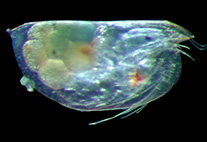Abstract
Jubogaster towai gen. et sp. nov. is described from a colony of Pheidole xanthogaster Wilson (Hymenoptera: Formicidae) in the Peruvian Amazon. The new taxon is amongst the largest pselaphine species known. Its transverse head implies an affinity with Trogastrini (Pselaphinae: Euplectitae), but J. towai lacks typical characters diagnostic for trogastrines and possesses others, such as a Jubini-like pronotum and equally-sized tarsal claws, that obscure its systematic relationships. To place J. towai phylogenetically, we sequenced a fragment of 28s rDNA for the new species and a range of other pselaphines, including members of Trogastrini and other tribes of Euplectitae. The topology produced by this analysis supports the inclusion of Jubogaster in Trogastrini, thereby indicating that morphology within this tribe can be more malleable than previously thought. Many of the largest pselaphine taxa are guests of social insect colonies. We discuss whether an evolutionary correlation (or causal relationship) exists between body enlargement and an inquilinous lifestyle in Pselaphinae.

